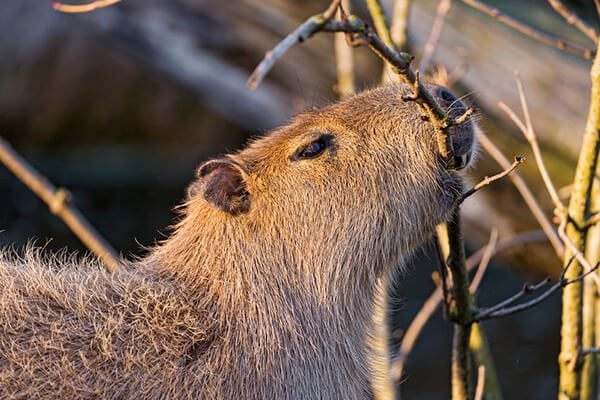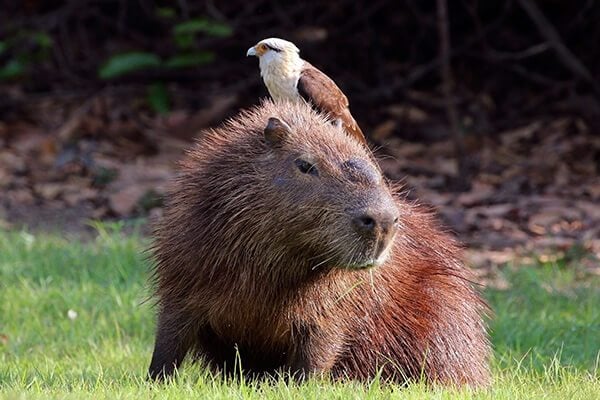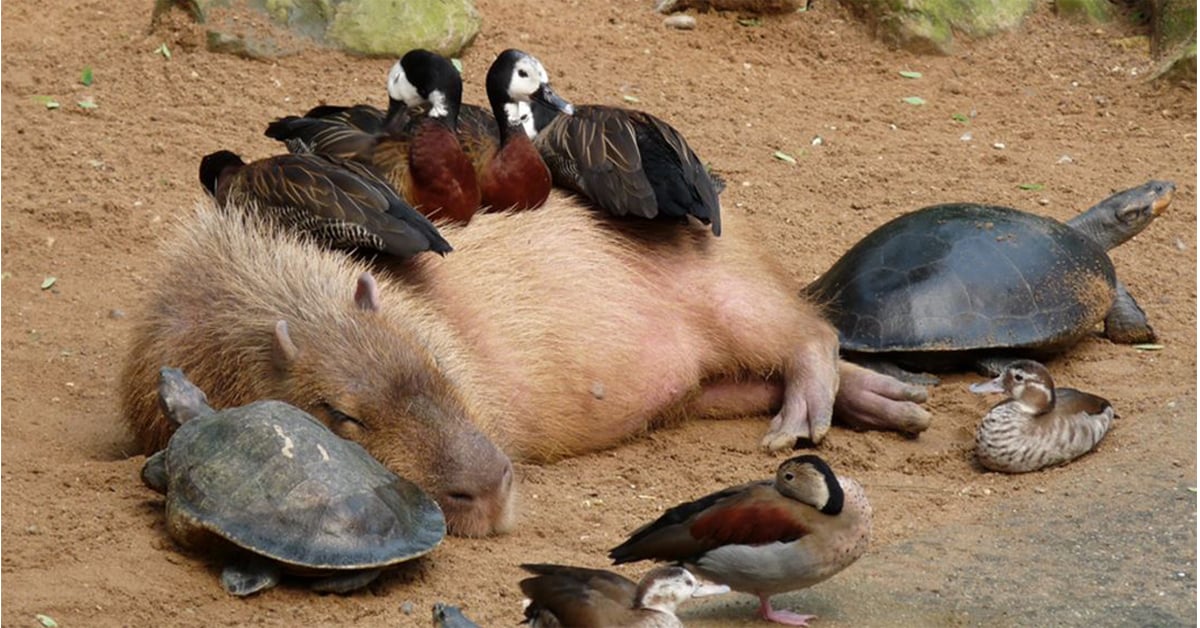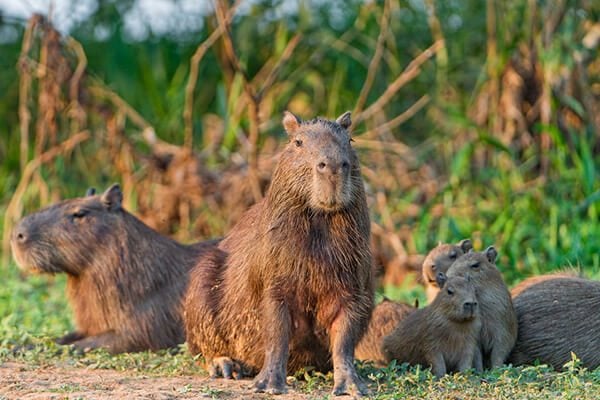Feb 27, 2018
|Last updated on March 18th, 2021 at 11:31 am
10 Amazon Facts About Capybaras in South America
Capybaras are the cutest, friendliest and largest South American forest rodents you’ve ever laid eyes on. In this article, we will discuss 10 Amazing Facts About Capybara, including what capybaras are, where capybaras live, what capybaras eat, and having capybara as a pet! We’ll even throw in some adorable capybara pictures of baby capybaras that are sure to make your heart melt.
First up on our list of 10 amazing facts about the capybara in South America is…
#1: Capybaras are the world’s largest rodent
 First on the list of 10 Amazing Facts About Capybara is that they are the “world’s largest rodent”! It’s true. Capybaras can reach up to 4 feet in length and weigh up to 145 pounds or more! These large creatures go by the names chigüire, carpincho, or capys if you’re me! They are a member of the Hydrochoerus family and visually resemble a larger version of a guinea pig. Other species that are similar in resemblance are coypu, also known as nutria, and the pacarana, a slow-moving rodent that is indigenous to South America.
First on the list of 10 Amazing Facts About Capybara is that they are the “world’s largest rodent”! It’s true. Capybaras can reach up to 4 feet in length and weigh up to 145 pounds or more! These large creatures go by the names chigüire, carpincho, or capys if you’re me! They are a member of the Hydrochoerus family and visually resemble a larger version of a guinea pig. Other species that are similar in resemblance are coypu, also known as nutria, and the pacarana, a slow-moving rodent that is indigenous to South America.
#2: Capybaras live in South America
 Capybaras live east of the Andes on Central and South American riverbanks. Ponds, lakes, marshes are their stomping ground. Water is an incredibly important life source for the capybara for two main reasons: to maintain a healthy lifestyle and ensure safety. Capybaras maintain a healthy lifestyle by nourishing their dry skin in water. It’s also a helpful hiding spot when danger is near. Places you might find them are the Amazon and even in cities like Belo Horizonte, Brazil. Learn more about South America Nature Tours where you might spot a capybara!
Capybaras live east of the Andes on Central and South American riverbanks. Ponds, lakes, marshes are their stomping ground. Water is an incredibly important life source for the capybara for two main reasons: to maintain a healthy lifestyle and ensure safety. Capybaras maintain a healthy lifestyle by nourishing their dry skin in water. It’s also a helpful hiding spot when danger is near. Places you might find them are the Amazon and even in cities like Belo Horizonte, Brazil. Learn more about South America Nature Tours where you might spot a capybara!
#3: Capybaras are vegetarians
 Next up on our list of 10 Amazing Facts about the Capybara in South America is that capybaras are vegetarians and have a hefty appetite! Capybara can eat up to 8 pounds a day of water plants and grasses! They have long, sharp teeth that continuously grow and are useful when breaking down various types of plants. During the dry season, capybaras feast on grains, melons, and squash. Interestingly enough, capybaras eat their food by chewing from side to side, instead of up and down the way we do. Chewing from side to side helps capybaras eat tough plant materials. In general, capybaras eat in the morning and the evening. However, if they feel threatened by nearby predators, they can wait until late in the evening to refuel. All the veggies capybaras eat can really add up as the large rodents can grow to weigh up to 150 pounds!
Next up on our list of 10 Amazing Facts about the Capybara in South America is that capybaras are vegetarians and have a hefty appetite! Capybara can eat up to 8 pounds a day of water plants and grasses! They have long, sharp teeth that continuously grow and are useful when breaking down various types of plants. During the dry season, capybaras feast on grains, melons, and squash. Interestingly enough, capybaras eat their food by chewing from side to side, instead of up and down the way we do. Chewing from side to side helps capybaras eat tough plant materials. In general, capybaras eat in the morning and the evening. However, if they feel threatened by nearby predators, they can wait until late in the evening to refuel. All the veggies capybaras eat can really add up as the large rodents can grow to weigh up to 150 pounds!
#4: Capybaras are semi-aquatic
 Capybaras are built like a mini barrel with short legs and webbed feet which are perfect for swimming. So yes, they are semi-aquatic creatures! You can find capybaras lounging near small bodies of water for most of the day. During midday, as the temperature increases, capybaras wade in the water to keep cool.
Capybaras are built like a mini barrel with short legs and webbed feet which are perfect for swimming. So yes, they are semi-aquatic creatures! You can find capybaras lounging near small bodies of water for most of the day. During midday, as the temperature increases, capybaras wade in the water to keep cool.
#5: Capybaras can live up to 12 years
Want another amazing fact about capybaras in South America? They can live from 8 to 12 years! Baby capybaras have a shorter life-span as they easily fall victim to predators.
#6: Capybaras are extremely friendly
 Capybaras are extremely friendly and highly social creatures. They relax in groups of 10 to 20 and interact with just about every other animal you can imagine. Simply Google search “images of friendly capybaras” and you will see photos of capybaras and baby capybaras cuddling with birds, kittens, puppies, goats, monkeys and more. Capys are often referred to as “living chairs” or “nature’s ottoman” because animals use their body as a resting spot. In fact, birds, monkeys, rabbits and baby capybaras have been photographed sitting and lounging atop the large rodents.
Capybaras are extremely friendly and highly social creatures. They relax in groups of 10 to 20 and interact with just about every other animal you can imagine. Simply Google search “images of friendly capybaras” and you will see photos of capybaras and baby capybaras cuddling with birds, kittens, puppies, goats, monkeys and more. Capys are often referred to as “living chairs” or “nature’s ottoman” because animals use their body as a resting spot. In fact, birds, monkeys, rabbits and baby capybaras have been photographed sitting and lounging atop the large rodents. 
#7: Capybaras travel in groups
 Capybaras usually live in small groups of about 10 individuals. It is common for there to be one dominant male, one or more females, one or more subordinate males and several baby capybaras in the group. A group setting allows multiple sets of eyes to watch over baby capybaras as they easily fall victim to caimans, jaguars, ocelots, anacondas, eagles and more.
Capybaras usually live in small groups of about 10 individuals. It is common for there to be one dominant male, one or more females, one or more subordinate males and several baby capybaras in the group. A group setting allows multiple sets of eyes to watch over baby capybaras as they easily fall victim to caimans, jaguars, ocelots, anacondas, eagles and more.
#8: Capybaras love to chat
You may have gathered that since capybaras are friendly and lounge in large groups that they are also very chatty! When capybaras are amongst one another, they make all sorts of noises. Listen closely and you will hear either clicking, whistling or purring. If capybaras want to alert their fellow mates of something important, they will bark like dogs!
#9: Jaguars prey on capybara!
 As mentioned above, baby capybaras are hunted by a number of different species. It is more difficult for baby capybaras to escape danger due to their lack of swimming skills. Instead of hiding underwater, baby capybaras find thick shrubbery to use as a hiding place. Adult capybaras can easily use ponds, lakes or marshes to escape danger (primarily the jaguar). In fact, they can stay underwater for up to five minutes at a time! The placement of their eyes, ears, and nostrils (near the top of their head) make it so they can easily see their surroundings without fully emerging from the water. Spot Jaguars, capybaras and other wild species on an Amazon rainforest tour!
As mentioned above, baby capybaras are hunted by a number of different species. It is more difficult for baby capybaras to escape danger due to their lack of swimming skills. Instead of hiding underwater, baby capybaras find thick shrubbery to use as a hiding place. Adult capybaras can easily use ponds, lakes or marshes to escape danger (primarily the jaguar). In fact, they can stay underwater for up to five minutes at a time! The placement of their eyes, ears, and nostrils (near the top of their head) make it so they can easily see their surroundings without fully emerging from the water. Spot Jaguars, capybaras and other wild species on an Amazon rainforest tour!
#10: You can have a capybara as a pet
 Last on the list of 10 Amazing Facts about Capybara, is their ability to be your household pet. It might not be common in your neighborhood, but you can have a capybara as a pet! However, there are some things you must consider. Capybaras need a great deal of outdoor space (preferably grass to graze on) and a source of water such as a size-able pool or nearby lake or pond. You must remember that capybaras, as cute and cuddly as they are, are wild animals that are not used to living domestically. So, if you are looking for a capybara for sale or considering having them as a pet, make sure that their new habitat closely resembles what they would need if they were in the wild! Make sure to also check whether what states capybara is legal in. We know that capybara for sale in states like California can be difficult to find and come with many restrictions.
Last on the list of 10 Amazing Facts about Capybara, is their ability to be your household pet. It might not be common in your neighborhood, but you can have a capybara as a pet! However, there are some things you must consider. Capybaras need a great deal of outdoor space (preferably grass to graze on) and a source of water such as a size-able pool or nearby lake or pond. You must remember that capybaras, as cute and cuddly as they are, are wild animals that are not used to living domestically. So, if you are looking for a capybara for sale or considering having them as a pet, make sure that their new habitat closely resembles what they would need if they were in the wild! Make sure to also check whether what states capybara is legal in. We know that capybara for sale in states like California can be difficult to find and come with many restrictions.



